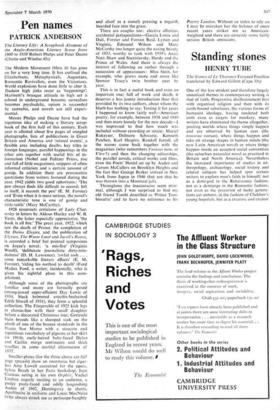Pen names
PATRICK ANDERSON
The Literary Life: A Scrapbook Almanac of the Anglo-American Literary Scene from 1900 to 1950 Robert Phelps and Peter Deane (Chatto and Windus 45s) The Modern Movement (bless it) has gone on for a very long time. It has outlived the Elizabethans, Metaphysicals, Augustans, Romantic Revivalists, even the Victorians. World explosions have done little to alter it. Dadaist high jinks recur as `happenings'; Marinetti's brusque attitude to high art is echoed in underground bosoms; surrealism becomes psychedelic, opium is succeeded by cannabis, and novels are still experi- mental.
Messrs Phelps and Deane have had the ingenious idea of making a literary scrap- book of the first half of this century. Each year is allotted about five pages of mingled photographs, lists of publications in Great Britain and America and 'related events', a flexible area including deaths, key titles in foreign languages, parallel happenings in the other arts together with useful bits of in- formation (Nobel and Pulitzer Prizes, rise and fall of little magazines), snippets of often informal criticism and a certain amount of gossip. In addition there are provocative quotations from writers featured during the year. 1942 yields two good aphorisms: 'The pen always finds life difficult to record; left to itself, it records the pen' (E. M. Forster) and 'Even when it is most serious, the novel's characteristic tone is one of gossip and tittle-tattle' (Mary McCarthy).
1928 resurrects criticisms of Lady Chat- terley in letters by Aldous Huxley and W. B. Yeats, the latter especially appreciative, 'the book is all fire.' The great year, 1922, which saw the death of Proust. the completion of the Duino Elegies, and the publication of Ulysses, The Waste Land and Jacob's Room, is accorded a brief but pointed symposium on Joyce's novel: 'a mis-fire' (Virginia Woolf), 'deliberate journalistic dirty-min- dedness' (D. H. Lawrence), 'awful tosh . . . some remarkable literary effects' (E. M. Forster), 'riding his method to death' (Ford Madox Ford, a writer, incidentally, who is given his rightful place in this com- pilation).
Although some of the photographs are familiar and many are formally posed (strong-jawed super-efficient Day Lewis of 1930, black helmeted crucifix-bechained Edith Sitwell of 1931), they form a splendid collection". The Fitzgeralds of 1925 kick legs in chorus-line with their small daughter before a decorated Christmas tree; Gertrude Stein broods like a slumped sack on the plinth of one of the bronze standards in the Piazza San Marco with a staccato and repetitious vocabulary of pigeons at her skirt (in 1914); curly-haired baby-faced Dylan and Caitlin merge sentiments and thick woollies in some marital chiaroscuro of 1937.
Smaller-plates (for the three above are full page spreads) show an enormous but cigar- less Amy Lowell accoutred for the opera. Sylvia Beach in her Paris bookshop, Jean Cocteau acting in his own Orphie, Vachel Lindsay eagerly reciting to an audience, a Pudgy pasty-faced and oddly languishing Auden of 1942, Hemingway in shorts, Apollinaire in uniform and Louis MacNeice (who always struck me as periscope-haughty
and aloof as a camel) pressing a roguish, bearded face into the grass.
There are couples too: elective affinities, accidental juxtapositions—Garcia Lorca and Dali, Forster and Forrest Reid, Lytton and Virginia, Edmund Wilson and Mary McCarthy (no longer quite the raving beauty of 1933, worthy to rank with 1939's Anais Nin), Shaw and Stanislaysky, Hardy and the Prince of Wales. And there is always the interest of following an author through a succession of appearances: Miss Stein, for example, who grows more and more like Spencer Tracy's twin brother year by year.
This is in fact a useful book and even an important one; full of work and death, it deserves a less jaunty introduction than that provided by its two authors, about whom the blurb has nothing to say. Testing it for years I happened to know fairly well—American poetry, for example, between 1938 and 1940 and then more loosely for the new decade—I was impressed to find how much was included without crowding or strain : Muriel Rukeyser, Delmore Schwartz, Kenneth Patchen, Karl Shapiro, Randall Jarrell, all the names came back together with the magazines (who remembers Furioso now, or View?) and then the changing editorships, the parallel novels, critical works and films, even the Poets' Hostel set up by Auden and Carson McCullers on Brooklyn Heights and the fact that George Barker arrived in New York from Japan in 1940 (but not that he was thrown into a Montreal jail).
Throughout the inaccuracies seem mini- mal, although I was surprised to find my old friend Tambi described as 'Prince Tarn- bimuttu' and to have no reference to his
Poetry London. Without an index to rely on I may be mistaken but the balance of more recent years strikes me as American- weighted and there are certainly some fairly serious British omissions.


































 Previous page
Previous page